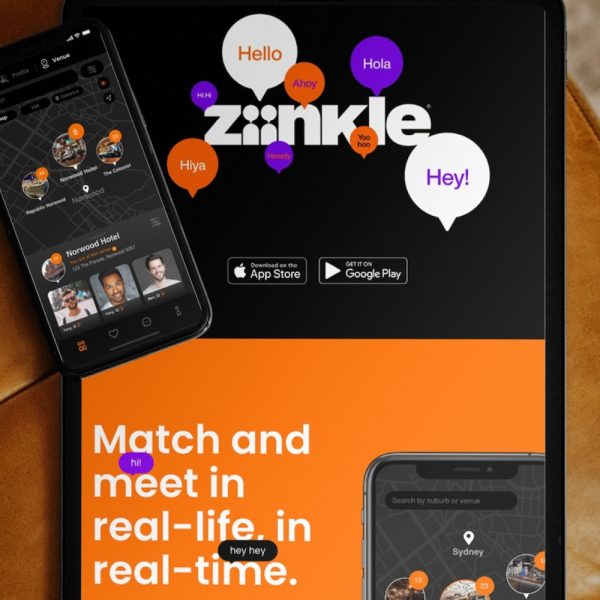Social & Dating App Development for Building Lasting Connections
Expert social app developers building dating apps, social networks, and community platforms with real-time messaging, sophisticated matching algorithms, and comprehensive safety features. From profile creation to community moderation - we build apps users trust and return to daily.

Connecting People with Precision
Social and dating app development demands unique expertise beyond standard app development. You're building digital environments where real people form relationships, share vulnerabilities, and invest emotional energy. Get the user experience wrong, and they leave. Fail at safety, and you face liability. Neglect engagement mechanics, and users ghost after initial curiosity. We build social and dating apps that balance three critical elements: meaningful connections (the core value), safety and trust (non-negotiable foundation), and habit-forming engagement (what drives daily active usage and retention).
As specialised social app developers, we've built platforms across the social spectrum: dating apps with sophisticated matching algorithms and safety features, niche social networks connecting communities around shared interests, creator platforms enabling content sharing and monetisation, and community forums with moderation and engagement tools. Each requires different technical architecture, but all share common challenges: real-time messaging infrastructure, content moderation at scale, privacy and safety features, and engagement mechanics that drive retention without manipulation.
Social App Development vs Dating App Development: Key Differences
The social and dating app landscape is intensely competitive. Users have hundreds of alternatives downloaded on their phones. Your app must deliver immediate value (users see relevant connections quickly), feel safe (verification, moderation, blocking tools work seamlessly), and create habits (push notifications, streaks, and engagement loops bring users back daily). We've studied what makes users stick with social apps versus churning after download—and we build those retention mechanics into every platform we develop.
Dating App Development Focus
Dating apps optimise for 1-to-1 connections leading to offline relationships. Core development priorities include:
- Matching Algorithms: Recommending compatible profiles based on preferences, behaviour, and location (Tinder swipe algorithm, Hinge compatibility scores, eHarmony compatibility matching)
- Profile Creation: Showcasing personality through photos, prompts, and verification (photo quality critical, bio prompts encouraging authenticity, verification badges building trust)
- Safety Features: Protecting users from harassment, catfishing, and dangerous situations (photo verification, reporting and blocking, background checks for certain platforms, in-app video calling before meetups)
- Conversation Starters: Reducing awkward initiation through prompts, questions, or structured messaging (Bumble women-message-first, Hinge comment-on-prompts, Coffee Meets Bagel icebreakers)
- Monetisation Through Premium: Freemium with paid features increasing match success (unlimited swipes, see who liked you, profile boosts, super likes, rewind last swipe)
Social Media App Development Focus
Social networks optimise for many-to-many connections, content sharing, and community engagement. Core development priorities include:
- Content Creation & Sharing: Easy posting of text, photos, videos, stories, live streams (Instagram feed and stories, TikTok video creation, Twitter threads, Facebook posts)
- Feed Algorithms: Surfacing relevant content from connections and communities (chronological vs. algorithmic feeds, engagement-based ranking, personalised recommendations)
- Social Graph: Following, friends, connections with bidirectional or unidirectional relationships (Twitter follow model, Facebook friend requests, LinkedIn connections)
- Engagement Mechanics: Likes, comments, shares, reactions driving participation (Instagram hearts, Facebook reactions, Twitter retweets, TikTok duets)
- Community Features: Groups, hashtags, trending topics, communities organised around interests (Reddit subreddits, Facebook Groups, Discord servers, Twitter Spaces)
Hybrid Social & Dating Apps
Some platforms blend social networking with dating:
- Friend-finding apps (Bumble BFF—same platform, different intent)
- Interest-based social apps with optional dating (Meetup with romantic options)
- Community platforms with 1-to-1 connections (fitness communities where relationships form organically)
- Social networks with dating features (Instagram DMs evolving into dating, BeReal adding friend-matching)
Why Social & Dating Entrepreneurs Choose PixelForce
Creating a successful dating or social app requires technical skill, user insight, and a deep understanding of the social space. PixelForce delivers these elements with a focus on reliability, security, and user engagement.
- Real-Time Infrastructure Expertise: Built messaging systems handling millions of daily messages with sub-second delivery, online presence indicators, typing notifications, and read receipts. Social apps live or die based on real-time performance—we've solved the technical challenges at scale.
- Safety & Moderation Experience: Implemented comprehensive safety features including AI-powered content moderation (detecting inappropriate images, hate speech, spam automatically), photo verification systems (preventing catfishing through selfie matching), reporting and blocking tools (empowering users to protect themselves), human moderation workflows (escalating serious violations to review teams), and age verification (ensuring underage users don't access adult platforms).
- Matching & Recommendation Algorithms: Developed sophisticated algorithms for dating apps including preference-based filtering (age, location, interests, dealbreakers), collaborative filtering (users who liked profile X also liked Y), behavioural signals (swipe patterns, message engagement, profile completion), and ELO-based scoring systems (matching users of similar "desirability" based on mutual interest patterns).
- Engagement Mechanic Design: Built habit-forming features driving daily active usage: push notifications (new matches, messages, profile views—carefully calibrated to avoid annoyance), streaks and gamification (maintaining daily login habits), feed algorithms (showing most engaging content first), and limited-time features (stories, daily picks, time-limited boosts creating urgency).
- Monetisation Strategy: Implemented proven freemium models for social and dating apps including subscription tiers (premium features increasing connection success), in-app purchases (boosts, super likes, rewinds), advertising (sponsored profiles, native ads in feeds—without degrading experience), and virtual goods/gifting (profile customisation, digital gifts, special reactions).
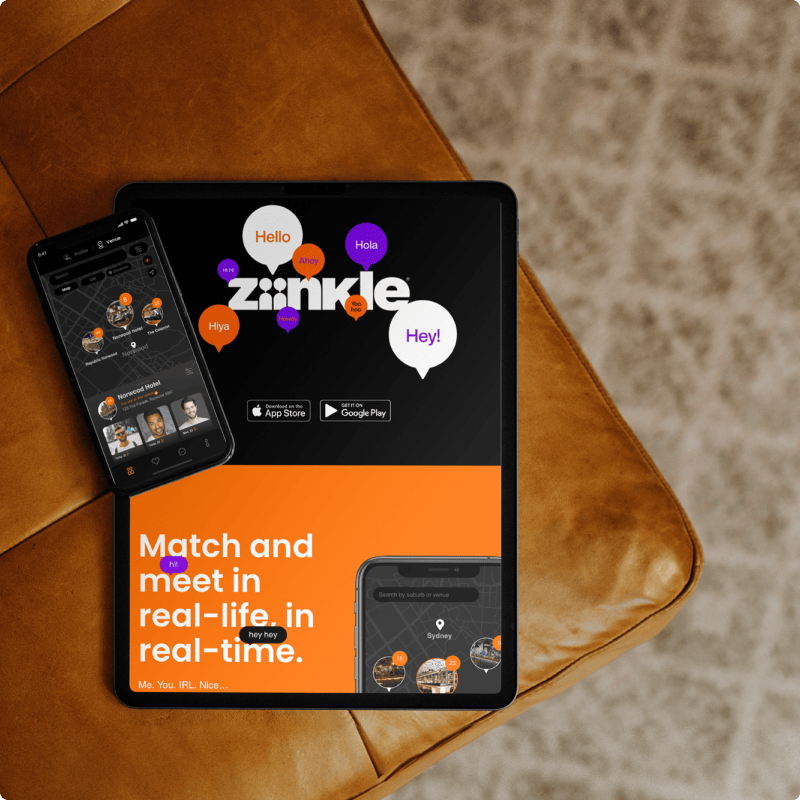
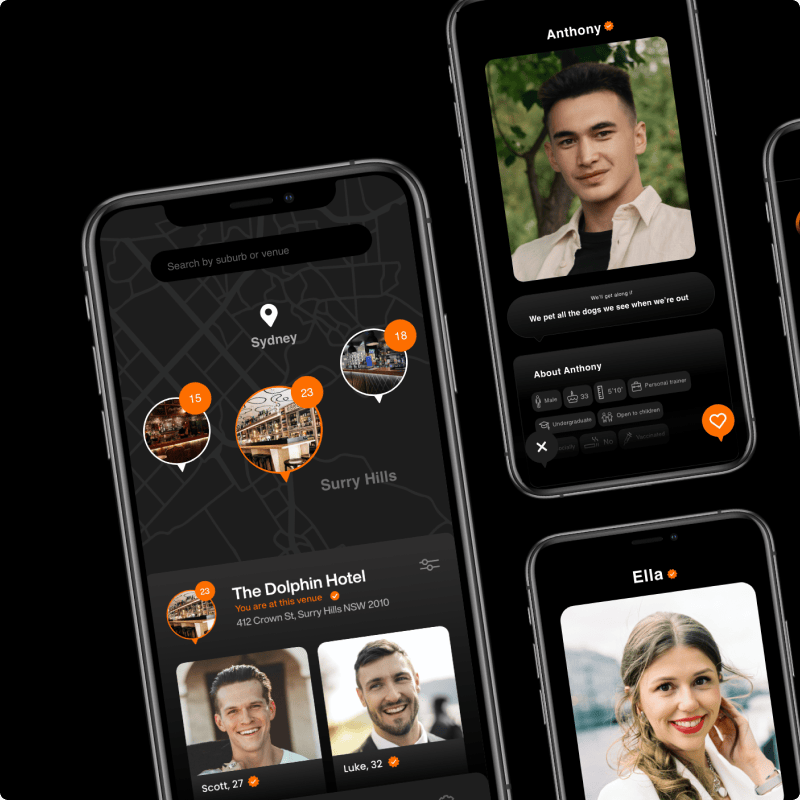
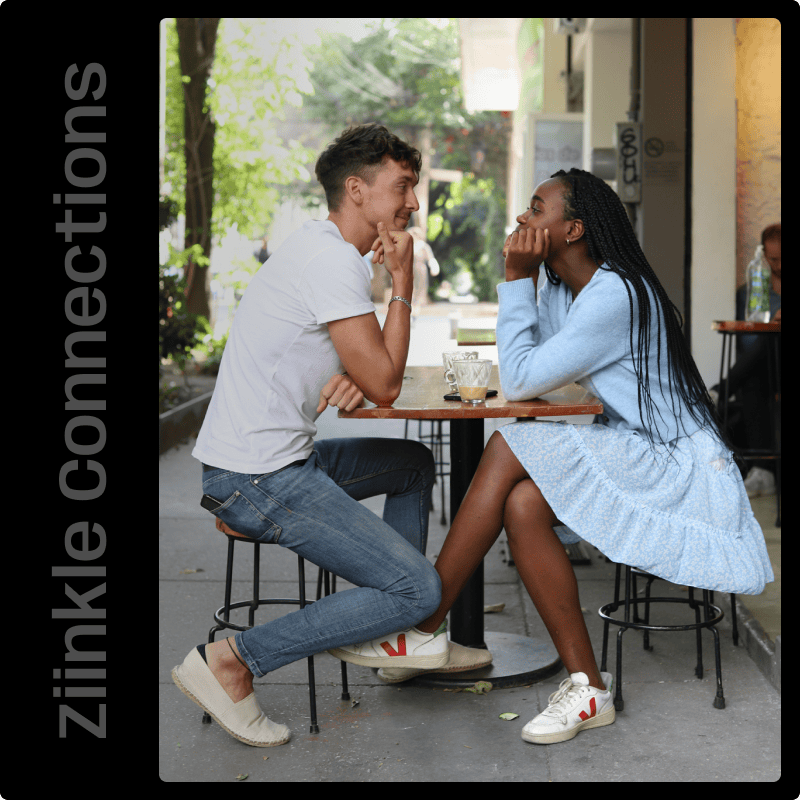
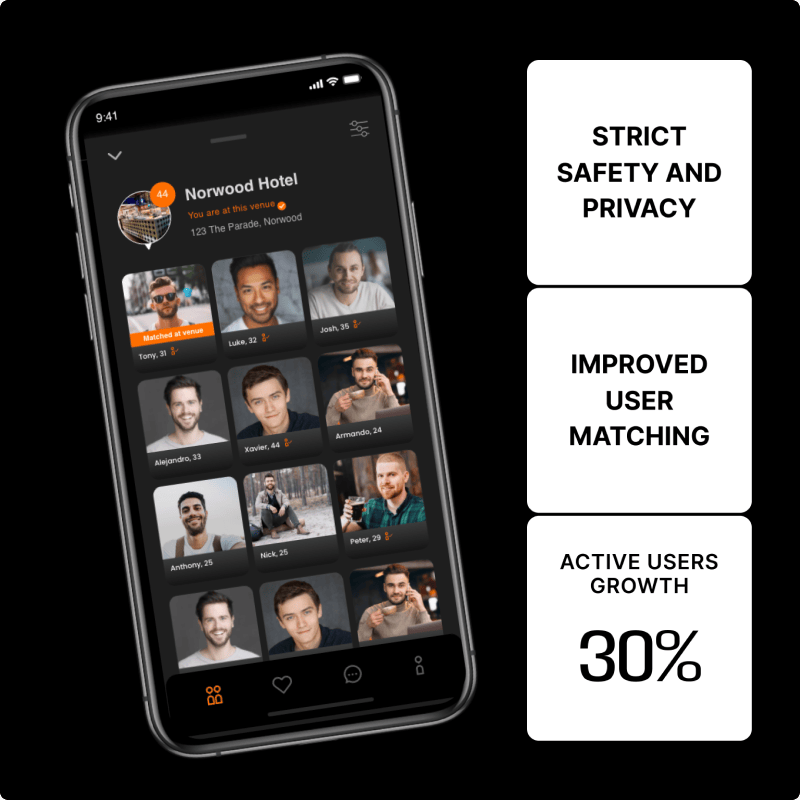
Social & Dating App Development Services
Dating App Development
Building platforms connecting people romantically. Features include profile creation with photos and prompts (showcasing personality beyond photos), matching algorithms (swipe-based like Tinder, curated daily matches like Coffee Meets Bagel, compatibility-based like eHarmony, proximity-based like Happn), real-time messaging (text, photos, GIFs, voice messages, video calling), profile verification (photo verification preventing catfishing, email/phone verification, social media linking, ID verification for premium safety), discovery filters (age, distance, height, education, interests, dealbreakers), premium features (see who liked you, unlimited swipes, profile boosts, rewind last swipe, incognito browsing), and safety tools (reporting and blocking, location hiding, in-app video calls before meetups, safety tips and resources).
Niche Dating App Opportunities: Broad dating apps face intense competition from Tinder, Bumble, Hinge. Success often comes through niche focus: religious dating (Christian Mingle, JDate, Muzmatch), demographic-specific (OurTime for 50+, Grindr for gay men), interest-based (Equestrian Cupid for horse lovers, Tastebuds for music), lifestyle-focused (Veggly for vegans, 420 Singles for cannabis users), serious relationships vs. casual (eHarmony vs. Tinder positioning), or professional dating (The League, Raya for verified professionals and creatives).
Social Networking App Development
Building platforms for content sharing and community connection. Features include user profiles with customisation (bios, profile photos, cover images, custom URLs), content posting (text, photos, videos, links, polls, live streams), feed algorithms (showing relevant content from connections, balancing chronological vs. engagement-based), social graph management (following/unfollowing, friend requests, connection suggestions, mutual friends), engagement mechanics (likes, comments, shares, reactions, bookmarks), notifications (new followers, post engagement, mentions, direct messages), search and discovery (finding people, content, trending topics), and privacy controls (public vs. private accounts, post visibility, blocking and muting).
Content Format Specialisation: Social networks often specialise by content type: photo-sharing (Instagram model—visual storytelling), short-form video (TikTok model—algorithmic viral potential), text-based (Twitter model—real-time conversations), long-form content (Medium model—thoughtful writing), live streaming (Twitch model—interactive broadcasting), or ephemeral content (Snapchat model—disappearing stories).
Community & Forum App Development
Building platforms for topic-based discussions and communities. Features include community creation and management (user-created communities around interests, moderator tools and permissions, community rules and guidelines), threaded discussions (nested comments, upvoting/downvoting, sorting by new/hot/top/controversial), content moderation (moderator queue, user reporting, automated spam detection, community guidelines enforcement), user reputation systems (karma or points from contributions, badges and achievements, trust levels unlocking privileges), search and discovery (finding relevant communities, trending topics, recommended communities), and notification preferences (following specific discussions, keyword alerts, moderator actions).
Examples: Reddit-style platforms (broad topic diversity, user-moderated communities), Discord-style (real-time chat with persistent communities), specialised forums (niche topics like parenting, investing, gaming), and Q&A platforms (Stack Overflow model—question and answer voting).
Creator Platform & Content Monetisation Development
Building platforms where creators build audiences and monetise content. Features include creator profiles and branding (customisable pages, bio links, portfolio showcases), content publishing tools (videos, podcasts, newsletters, courses, exclusive content), audience building (follower growth, email list building, community management), monetisation options (subscriptions, pay-per-content, tips/donations, sponsored content, affiliate links, merchandise), analytics dashboards (views, engagement, subscriber growth, revenue tracking), and fan engagement (comments, reactions, live streams, community access, exclusive perks for paying fans).
Models: Patreon-style (subscription tiers with exclusive perks), OnlyFans-style (pay-per-content with tips), Substack-style (newsletter subscriptions), YouTube-style (ad revenue sharing with tipping), or Cameo-style (personalised video requests).
Niche Social Network Development
Building focused social platforms around specific interests or demographics. Features include specialised profiles (fields relevant to niche—portfolios for artists, credentials for professionals, stats for athletes), niche-specific content (formats matching community needs—before/after photos for fitness, code snippets for developers, recipe cards for cooking), community features (groups, challenges, leaderboards tailored to niche), specialised discovery (finding connections based on niche criteria—skill level, location, specialisation), and integrations (connecting to niche tools—Strava for running, GitHub for developers, Goodreads for readers).
Successful Niches: Professional networking (LinkedIn model—career-focused), fitness communities (Strava model—activity tracking and social), parenting networks (Peanut model—connecting mothers), pet lovers (Rover social features), travelers (Couchsurfing community), book clubs (Goodreads social features), artists and designers (Behance, Dribbble), and musicians (SoundCloud social features).
Essential Social & Dating App Features
Profile Creation & Customisation
First impressions matter. Comprehensive profile features include:
- Photo uploads with cropping and filters
- Bio and about me sections
- Interests, hobbies, preferences
- Verification badges (photo verification, email/phone, social media linking, ID verification)
- Profile prompts (answering creative questions showcasing personality—Hinge model)
- Privacy settings (control who sees profile, location sharing, last active status)
Discovery & Matching
Helping users find relevant connections:
- Algorithm-driven recommendations
- Swipe interface (Tinder model—accept/reject quickly)
- Curated daily matches (limiting options increases decision quality)
- Proximity-based discovery (nearby users)
- Interest and preference filtering
- Mutual connections (friends-of-friends)
- Search functionality (finding specific users or content)
Real-Time Messaging
Seamless communication between users:
- Text messaging with emoji support
- Photo and video sharing
- Voice messages and audio clips
- GIF and sticker libraries
- Online/offline status indicators
- Typing indicators
- Read receipts (optional privacy setting)
- Message reactions (heart, laugh, etc.)
- Video and voice calling (in-app calls preventing phone number sharing)
Content Feed & Algorithm
Surfacing relevant content from connections:
- Chronological vs. algorithmic feed options
- Content ranking based on engagement signals
- Story/ephemeral content (24-hour disappearing posts)
- Explore/discovery feeds (content beyond connections)
- Trending topics and hashtags
- Personalised recommendations (based on interests, behaviour)
Safety & Moderation
Protecting users from harassment and harmful content:
- Photo verification (preventing catfishing through selfie matching)
- Reporting tools (easy reporting of users or content)
- Blocking and muting (user-controlled safety)
- AI content moderation (detecting nudity, hate speech, spam automatically)
- Human moderation queue (reviewing flagged content)
- Age verification (ensuring platform age restrictions)
- Safety tips and resources (educating users on safe usage)
- Background checks (for certain platforms—childcare, home services)
Engagement Mechanics
Features driving daily active usage:
- Push notifications (new matches, messages, profile views—carefully calibrated frequency)
- Streaks (maintaining daily usage habits—Snapchat model)
- Gamification (badges, achievements, levels)
- Limited-time features (daily picks, limited swipes creating urgency)
- Reactions and engagement (likes, comments, shares)
- Profile views counter (seeing who viewed your profile)
Social Graph Management
Building and maintaining connections:
- Follow/unfollow (unidirectional relationships—Twitter model)
- Friend requests (bidirectional relationships—Facebook model)
- Connection suggestions (people you may know)
- Mutual connections display
- Followers/following lists
- Import contacts (finding friends from phone or email)
Monetisation Features
Revenue generation through freemium and premium options:
- Subscription tiers (premium features—see who liked you, unlimited swipes)
- In-app purchases (boosts, super likes, rewind last action, profile customisation)
- Advertising (sponsored profiles in dating apps, native ads in social feeds)
- Virtual gifts (sending gifts to connections, badges, special reactions)
- Verification badges (paid verification for authenticity)
- Creator monetisation (subscriptions, tips, exclusive content access)
Social & Dating App Development Process
Phase 1: Product Strategy & User Psychology (Weeks 1-3)
Social and dating app development begins with understanding human behavior and connection patterns. We define your core value proposition (why users choose your app over alternatives), identify target demographic with precision (age, interests, relationship goals, platform habits), analyse competitive landscape (what's working, gaps in market, differentiation opportunities), design engagement loops (what brings users back daily—matching, messaging, content discovery, notifications), and plan safety and trust features (verification, moderation, reporting from day one—not afterthoughts).
Critical Questions: What makes your social/dating app different from hundreds of alternatives? Why will users evangelise it to friends? What's your chicken-and-egg strategy (need users to attract users)? What are your top 3 retention metrics?
Phase 2: UX/UI Design Optimised for Engagement (Weeks 4-8)
Designing social and dating apps requires psychological understanding beyond aesthetics. We create onboarding flows that hook users immediately (seeing relevant content or matches within 60 seconds), profile creation that's frictionless yet complete (progressive disclosure—start minimal, complete over time), swiping or content feeds that feel addictive without being manipulative, messaging interfaces optimised for conversations (reducing awkward silence through conversation starters), and notification strategies that re-engage without annoying (push notification timing, frequency, content critical).
Design Principles: Immediate value (users see why app matters in first session), easy participation (low barriers to engagement—liking, commenting, swiping), variable rewards (intermittent reinforcement through new matches, content, notifications), social proof (showing activity, popularity, validation), and safety cues (verification badges, moderation indicators, privacy controls prominent).
Phase 3: Development with Real-Time Infrastructure (Weeks 9-20)
Building social and dating apps with technical excellence. Platform development (native iOS/Android for premium experience or cross-platform for faster MVP), real-time messaging infrastructure (WebSocket or similar for instant message delivery, online presence, typing indicators), matching algorithm implementation (for dating apps—preference-based, behavioural, location-based), feed algorithm development (for social apps—ranking content by relevance, recency, engagement), content moderation systems (AI for initial screening, human review queue for borderline cases), photo verification (AI-powered selfie matching preventing catfishing), push notification infrastructure (targeted, personalised notifications driving engagement), and payment integration (subscriptions, in-app purchases through Apple/Google).
Technical Focus: Sub-second message delivery (real-time feels broken if laggy), scalable infrastructure (handling viral growth spikes), efficient algorithms (matching and feed computation at scale), and reliable notifications (must reach users consistently or engagement suffers).
Phase 4: Beta Testing with Target Demographic (Weeks 21-24)
Social and dating apps require testing with representative users in realistic scenarios. We conduct beta testing with 100-500 users matching target demographic, gathering qualitative feedback through interviews (understanding emotional responses, friction points, delight moments), quantitative analytics (tracking activation, engagement, retention, messaging patterns), A/B testing core flows (onboarding variations, matching algorithms, notification strategies), safety and moderation testing (ensuring reporting works, moderators can act quickly), and iterating based on behavioral data (what users do matters more than what they say).
Key Metrics: Activation rate (% completing profile and first action), day 1/7/30 retention (% returning after first use), DAU/MAU ratio (daily active users / monthly active users—shows stickiness), messages sent per user, matches leading to conversations (for dating apps), and content posted per user (for social apps).
Phase 5: Launch & Growth Strategy (Week 25+)
Launching social and dating apps requires network effects strategy. Initial launch with tight geographic or demographic focus (achieving density in single community before broader launch), referral incentives (existing users inviting friends—Tinder's college campus strategy), influencer and content creator partnerships (seeding app with interesting people attracting others), paid user acquisition (Facebook/Instagram ads targeting demographically), App Store Optimisation (keywords, screenshots, social proof driving organic downloads), and PR and media coverage (TechCrunch, lifestyle publications depending on niche).
Growth Focus: Retention matters more than acquisition—focus on daily active usage, engagement depth, and user satisfaction before scaling marketing spend. Leaky bucket (high churn) defeats growth efforts.
Social & Dating App Monetisation Strategies
Freemium Subscription Model (Most Common)
Free core features with premium subscriptions unlocking advanced functionality. Dating apps: see who liked you before swiping, unlimited swipes/matches, profile boosts (appear first in stacks), super likes (showing strong interest), rewind last swipe, incognito mode (browse privately), passport feature (change location to travel destinations), and read receipts. Social apps: ad-free experience, exclusive content access, advanced analytics, profile customisation, and creator tools (monetisation features for influencers).
Typical Pricing: $9.99-$29.99/month or $59.99-$199.99/year (annual provides 30-50% discount encouraging longer commitment). Premium features should meaningfully increase success rates (more matches, engagement, connections) justifying subscription.
In-App Purchases
One-time purchases for consumable features. Dating apps: profile boosts (temporary visibility increase), super likes packs (showing strong interest to specific profiles), rewind credits (undo last swipe), and spotlight features (appear first temporarily). Social apps: virtual gifts and reactions, profile customisation (themes, badges, special effects), content promotion (boosting posts to broader audience), and advanced filters or tools.
Conversion Strategy: In-app purchases work best when timed around user intent—offering profile boost after user runs out of daily swipes, suggesting super like when user dwells on attractive profile, or promoting post when user posts high-quality content wanting more visibility.
Advertising (Careful Implementation)
Ads can monetise free users without degrading experience if done carefully. Native ads in feeds (sponsored profiles in dating apps appearing in swipe stack, branded content in social feeds), banner ads in non-critical areas, rewarded video ads (watch ad to earn free boost, super like, or premium feature trial), and brand partnerships (exclusive events, experiences, promotions relevant to user base).
Critical Balance: Ads should never interfere with core experience—placing ads between matches or in messaging ruins user experience and drives churn. Successful apps keep ad load under 5-10% of content to maintain quality.
Creator Monetisation & Platform Cut
For creator-focused social platforms, take percentage of creator earnings. Typical models: platform takes 10-30% of subscription revenue (Patreon takes 5-12% depending on tier), transaction fees on tips and donations, revenue sharing on advertising (YouTube model—creators get 55%, platform gets 45%), or listing fees for paid content (OnlyFans takes 20%).
Advantage: Aligned incentives—platform succeeds when creators succeed. Requires building large, engaged creator base generating meaningful revenue.
Safety, Privacy & Moderation: Non-Negotiable Priorities
Social and dating app developers have ethical and legal obligations protecting users. We implement comprehensive safety systems from launch, not as afterthoughts:
User Verification & Trust
- Photo verification (AI-powered selfie matching preventing catfishing—users take real-time selfie matching profile photos)
- Email and phone verification (ensuring real people, not bots)
- Social media linking (optional verification through Facebook, Instagram, LinkedIn)
- ID verification (for platforms requiring age proof or enhanced trust—dating apps preventing minors, professional networks)
- Verification badges (visual indicators of verified users building trust)
Content Moderation
- AI-powered moderation (detecting nudity, violence, hate speech, spam automatically using computer vision and NLP)
- Human moderation queue (escalating borderline content for human review)
- User reporting tools (easy reporting of inappropriate profiles, messages, or content)
- Automated account suspension (for clear policy violations—nudity, harassment, spam)
- Appeal processes (allowing falsely flagged users to contest decisions)
- Proactive monitoring (scanning for patterns indicating coordinated abuse, scams, or bot networks)
User Safety Controls
- Blocking (preventing specific users from contacting or seeing your content)
- Muting (hiding user's content without them knowing)
- Privacy settings (control who sees profile, posts, location, last active status)
- Location hiding (showing approximate distance without exact coordinates)
- Incognito modes (browsing without appearing in "viewed your profile")
- Safety tips and resources (educating users on safe online interaction, meeting safely offline)
- In-app safety features (video calling before sharing phone numbers, reporting dangerous situations)
Legal Compliance
- Age restrictions (COPPA compliance preventing children under 13, dating apps requiring 18+)
- Data privacy (GDPR, CCPA compliance—user data rights, transparent policies, consent management)
- Terms of service and community guidelines (clearly communicated rules, consequences for violations)
- Reporting to authorities (procedures for handling illegal content—child exploitation, threats of violence)
- Liability protection (implementing reasonable safeguards, responding promptly to reports)
Safety isn't a checkbox—it's ongoing commitment. We help you build moderation systems scaling with your user base, train human moderators, refine AI models based on your community's needs, and continuously improve based on emerging safety challenges.
